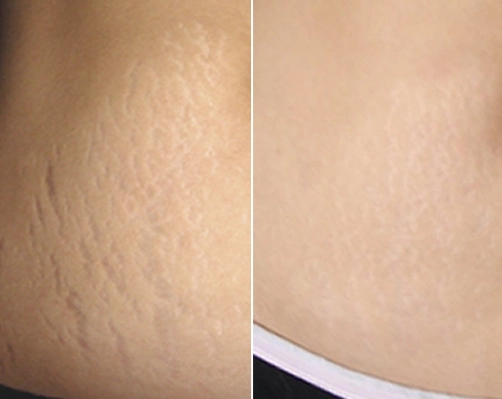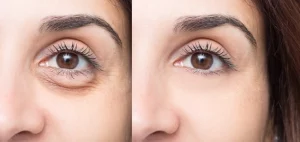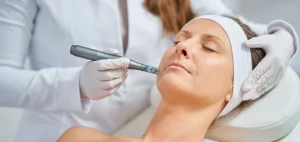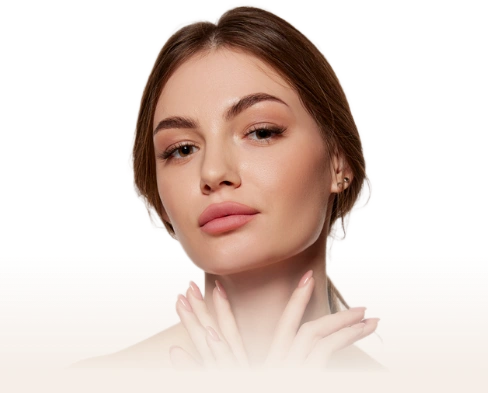Stretch marks are one of the most common skin concerns, affecting both women and men across different ages and skin types. They usually appear when the skin stretches rapidly due to pregnancy, puberty, weight changes, or muscle growth, causing the underlying collagen and elastin fibers to tear. This leaves behind streak-like lines that can look red, purple, or white depending on how old they are. Clinical studies suggest that up to 80% of people develop stretch marks at some point in their lives, most often on the stomach, thighs, hips, breasts, or arms. While completely harmless, many patients feel self-conscious about their appearance and seek reliable treatments that go beyond temporary creams or lotions.
Microneedling has emerged as one of the most effective solutions for reducing stretch marks. The treatment works by using ultra-fine, sterile needles to create controlled micro-injuries in the skin, which triggers the body’s natural healing response. This process stimulates collagen and elastin production, gradually repairing the damaged tissue that causes stretch marks to appear. Clinical studies have shown that microneedling not only improves the texture and color of stretch marks but also enhances overall skin quality. Originally introduced as a treatment for acne scars and skin rejuvenation, microneedling has since become a proven option for stretch marks because it works with the body’s biology, is safe for most skin types, and requires little downtime compared to lasers or chemical peels.
Dr. Syra Hanif is a board-certified aesthetics and wellness specialist recognized for her expertise in advanced skin rejuvenation treatments, including microneedling for stretch marks. With years of experience and a reputation for achieving natural, lasting results, she has helped many patients reduce the appearance of stretch marks and regain confidence in their skin. Known for her compassionate, patient-focused care, Dr. Hanif, at her Manhattan clinic, takes the time to thoroughly evaluate each individual’s needs before recommending treatment, ensuring both safety and effectiveness. Patients interested in improving the look of their skin can schedule a consultation to explore whether microneedling is the right solution for them.
What is microneedling treatment for stretch marks?
Stretch marks are common skin concerns that develop when the skin stretches or shrinks too quickly, often from pregnancy, weight changes, or growth spurts, leaving visible streaks on areas like the abdomen, thighs, or arms. Microneedling is a proven treatment that helps improve the appearance of these marks by using fine, sterile needles to create controlled micro-injuries in the skin, stimulating collagen and elastin production to restore smoother texture and more even tone. Over time, this natural healing response softens stretch marks and makes them less noticeable. Dr. Hanif offers microneedling treatment at her Manhattan office, where a consultation can help determine the best plan for healthier-looking skin.
PRP Microneedling for stretch marks
PRP microneedling, often called the “vampire facial” for the skin, is an advanced treatment that combines traditional microneedling with Platelet-Rich Plasma (PRP) therapy. During the procedure, a small sample of your blood is drawn and spun in a centrifuge to separate the PRP, which is rich in growth factors. This concentrated plasma is then applied to the microchannels created by the microneedling device, enhancing healing, boosting collagen production, and accelerating tissue repair. PRP microneedling is especially effective for stretch marks because it not only stimulates new collagen and elastin but also improves skin tone, texture, and overall elasticity, making stretch marks less visible over time.
Unlike creams or surface treatments that only hydrate, PRP microneedling works deep within the skin, delivering results that are more significant and longer lasting. It is safe for both men and women, across different skin types, and is often chosen by those who want a natural, non-surgical solution to improve the look of stubborn stretch marks. Dr. Hanif helps patients reduce the appearance of stretch marks by combining advanced techniques with a personalized approach that ensures safety and effective results. A consultation with Dr. Hanif will determine if PRP microneedling is the right treatment to restore smoother, healthier-looking skin.
What causes stretch marks?
Stretch marks are caused by rapid stretching or shrinking of the skin, which disrupts collagen and elastin fibers in the dermis and leaves visible streaks or lines on the surface. They commonly develop during pregnancy, growth spurts, rapid weight changes, intense muscle building, or due to hormonal fluctuations, and can appear on areas like the abdomen, thighs, hips, breasts, or arms. Genetics also play a role, making some people more prone than others. Since the severity and appearance of stretch marks vary from person to person, Dr. Hanif will assess your skin and recommend the most effective treatment options to help restore smoother, healthier-looking skin.
Types of stretch marks
The two most common types of stretch marks are striae rubrae and striae albae. Striae rubrae are the early-stage, red or purple marks that usually develop in teenagers going through puberty, pregnant women, or individuals experiencing rapid weight gain or muscle growth. They appear when the skin is newly stretched and blood vessels are still active, which makes them more responsive to treatment.
Over time, these marks fade into striae albae, which are older, white or silvery stretch marks that commonly affect adults after pregnancy, significant weight changes, or long-term skin stretching. Because albae are more mature and scar-like, they can be harder to treat than rubrae. If you’re dealing with either type, If you are dealing with either type, Dr. Hanif will assess your skin and recommend the most effective treatment options to improve their appearance and restore smoother, healthier-looking skin.
Microneedling for stretch marks procedures
Before the procedure, Dr. Hanif explains the importance of preparing the skin for best results. Patients are advised to avoid retinoids, harsh skincare products, and excessive sun exposure for several days leading up to treatment. On the day of the session, the skin is thoroughly cleansed, and a topical numbing cream is applied to ensure comfort.
During the procedure, Dr. Hanif uses a professional microneedling device with ultra-fine, sterile needles to create controlled micro-injuries across the stretch-marked areas. These tiny punctures stimulate the body’s natural healing process, encouraging collagen and elastin production. Depending on the treatment plan, she may also enhance results by combining microneedling with platelet-rich plasma (PRP), which is applied to the microchannels for faster healing and stronger skin remodeling. Most sessions last between 30 to 60 minutes, depending on the size of the treatment area, and patients typically tolerate the process well with minimal downtime.
Microneedling on stretch marks before and after

What to Expect After Microneedling (Downtime & Aftercare Tips)
After microneedling, most patients notice that their skin looks pink or slightly red, similar to a mild sunburn, and may feel warm or tight for the first 24–48 hours. Light swelling, pinpoint marks, or dryness can also appear as part of the healing process, and mild flaking may follow as the skin renews itself. Recovery time depends on the depth of treatment, but many people resume normal activities within a day or two.
To support healing, it’s important to follow gentle aftercare: avoid makeup, strenuous workouts, hot showers, or active skincare products such as retinoids and exfoliants for the first 24 hours. Using a mild cleanser, hydrating serum (like hyaluronic acid), and fragrance-free moisturizer helps keep the skin calm and comfortable. Sunscreen is essential, as the skin is more sensitive to UV rays after treatment. Over the next few weeks, collagen production increases, and the skin gradually looks smoother, healthier, and more even in tone.
How many microneedling sessions are needed for stretch marks?
The number of microneedling sessions needed for stretch marks can vary depending on how old or severe the marks are, the area being treated, and individual skin response. On average, most people see visible improvement after 3 to 6 sessions, spaced about 4 to 6 weeks apart to allow proper collagen remodeling. Early-stage stretch marks respond faster since they’re newer and have more active blood vessels, while older, white marks may require more sessions and sometimes benefit from enhanced options like PRP microneedling for stronger results. Dr. Hanif evaluates each patient’s skin during a consultation and then recommends the right number of sessions, ensuring the treatment plan is realistic, safe, and designed to achieve the best possible improvement.
Microneedling for Stretch Marks Cost in Manhattan, NYC
The cost of microneedling for stretch marks in Manhattan varies depending on several factors, including the size of the treatment area, the number of sessions needed, and whether advanced options like PRP (Platelet-Rich Plasma) or RF (Radiofrequency) are added to the procedure. Geographic location also plays a role; prices in Manhattan are typically higher than in other regions due to the demand for advanced aesthetic services. The provider’s level of expertise can influence cost, with highly experienced specialists often charging more than less experienced practitioners. Since each person’s skin and stretch marks are unique, there isn’t a one-size-fits-all cost. During a consultation, Dr. Hanif carefully evaluates your stretch marks and recommends the most effective treatment approach.
Who is a good candidate for microneedling stretch marks in NYC?
A good candidate for microneedling to treat stretch marks is someone in overall good health who wants to reduce the appearance of red or white marks caused by pregnancy, puberty, weight fluctuations, or muscle growth.
The treatment works well for both men and women, and it is safe across a wide range of skin types and tones. Microneedling is especially helpful for individuals who prefer a non-surgical, minimally invasive solution with little downtime. However, it is not recommended for those with active skin infections, certain medical conditions, or during pregnancy. At her NYC clinic, Dr. Hanif evaluates each patient’s skin, medical history, and goals before recommending microneedling. This personalized consultation helps determine whether microneedling is the right choice and ensures patients receive the safest and most effective treatment plan for smoother, healthier-looking skin.
Microneedling for stretch marks side effects and risks
Microneedling for stretch marks is generally safe when performed by an experienced professional, but like any cosmetic procedure, it comes with some temporary side effects. The most common include mild redness, swelling, or sensitivity in the treated area, similar to a light sunburn. Some patients may also notice pinpoint bleeding, flaking, or dryness as the skin heals. These effects usually resolve within a few days.
Less common risks include temporary hyperpigmentation, acne flare-ups, or skin irritation if aftercare instructions are not followed. Very rarely, infection or abnormal scarring (such as keloids) can occur, particularly in individuals with a history of these conditions.
How to get started with microneedling treatment?
Stretch marks are a common concern for both men and women, often appearing after pregnancy, rapid weight changes, puberty, or muscle growth, and they can make the skin look uneven and scarred. While not harmful, many people feel self-conscious and seek effective ways to reduce their appearance. Microneedling is one of the most reliable treatments, as it stimulates collagen and elastin production to naturally repair and smooth the skin. At Dr. Syra Aesthetics in NYC, Dr. Syra Hanif offers professional microneedling treatments, typically recommending 3 to 6 sessions for visible, lasting improvement. To take the first step toward smoother, healthier-looking skin, patients can schedule a consultation by calling +1-646-912-8020.
FAQs about microneedling for stretch marks
Does microneedling help stretch marks?
Yes, microneedling does help improve the appearance of stretch marks. Stretch marks form when the skin stretches too quickly and the collagen and elastin fibers beneath the surface break down, leaving behind visible lines or grooves. Microneedling works by creating tiny, controlled micro-injuries in the skin using fine, sterile needles. These microchannels stimulate the body’s natural healing response, encouraging the production of new collagen and elastin to repair and strengthen the skin. Over time, this remodeling process helps soften stretch marks, improve skin texture, and restore a smoother, more even appearance.
Both early red or purple stretch marks and older white or silvery marks can respond to microneedling, though newer marks often improve faster because they are still active and have more blood supply. With a series of treatments, most patients notice their stretch marks becoming less noticeable and their skin looking firmer and healthier.
Are stretch marks permanent?
Stretch marks are not completely permanent, but they also don’t go away on their own without treatment. Fresh stretch marks (the red or purple ones) usually fade with time into older white or silvery marks, but they rarely disappear completely. They can show up during pregnancy, puberty, rapid weight gain or loss, or even muscle growth, and they affect both men and women of all ages.
Treatments like microneedling have been shown in studies to make a big difference; most people see around 50% or more improvement after a few sessions, and results are even better when PRP is added. Some patients notice outcomes that are close to what lasers achieve, but with less downtime and lower risk. Since everyone’s skin and stretch marks are different, the best way to know what results you can expect is to meet with Dr. Hanif in Manhattan, where she can look at your skin and guide you toward the safest and most effective plan.
What’s the difference between microneedling and Dermapen?
Microneedling and Dermapen are actually closely related; the main difference is in the device used. Microneedling is the general treatment itself, where fine, sterile needles create tiny micro-injuries in the skin to stimulate collagen and elastin production. This process helps with issues like acne scars, stretch marks, wrinkles, and overall skin texture.
Dermapen, on the other hand, is a brand of microneedling device. It’s a pen-shaped, motorized tool that moves the needles up and down in a controlled, automated way. Compared to older manual rollers (dermarollers), Dermapen allows for more precision, adjustable needle depth, and consistent results with less trauma to the skin. Because of this, patients usually experience less discomfort and faster healing with Dermapen compared to traditional rolling methods.
Is microneedling better than laser for stretch marks?
Microneedling works by creating tiny, controlled micro-injuries in the skin, which trigger your body’s natural healing response stimulating collagen and elastin growth to repair stretch-marked areas. Because it’s more mechanical and gentle, it typically has less downtime, fewer side effects, and a lower risk of pigmentation changes, especially for darker skin tones. In contrast, laser treatments use heat energy to resurface and remodel tissue, which can deliver faster results for some cases, but also carries higher risks of redness, prolonged recovery, and pigment changes.
For many patients, microneedling provides a safer, more balanced approach with gradual yet noticeable improvement in texture and tone. If you’re trying to decide whether microneedling or laser is better for your stretch marks, a consultation with Dr. Hanif can help. She evaluates your skin, stretch-mark characteristics, and goals before recommending the treatment whether microneedling, laser, or a combination to achieve the best results for your skin.
How long does it take to recover from microneedling for stretch marks?
Recovery from microneedling for stretch marks is usually quick compared to other resurfacing treatments. Most patients experience redness, mild swelling, or skin sensitivity right after the procedure, similar to a light sunburn. This typically lasts 24–48 hours, though in some cases, mild flaking or dryness can continue for 3–5 days as the skin naturally heals and renews itself.
During this time, it’s important to keep the skin hydrated, avoid harsh skincare products, and protect it with sunscreen since it’s more sensitive to UV rays. Makeup and normal routines can usually be resumed after the first day or two.
The skin continues repairing and building collagen beneath the surface for weeks, which is why results improve gradually with each session. While the surface recovery is fast, the true benefits—smoother texture and reduced stretch marks become more noticeable over the following week
Can Microneedling Permanently Remove stretch marks?
It’s not recommended to perform microneedling for stretch marks at home. While there are DIY derma rollers available, they usually have much shorter needles that don’t penetrate deep enough to remodel collagen in the way professional treatments do. More importantly, using longer needles at home carries real risks improper technique or lack of sterile equipment can lead to infection, scarring, or worsening of stretch marks.
Microneedling is performed with medical-grade devices like the Dermapen, which can safely reach the deeper layers of the skin under expert supervision. This allows for controlled, effective collagen stimulation while minimizing risks.
For safe and noticeable results, it’s best to leave microneedling for stretch marks to a qualified provider. At her Manhattan office, Dr. Syra Hanif offers professional microneedling treatments in a sterile environment, ensuring both safety and effectiveness. Patients can book a consultation with Dr. Hanif to explore the best approach for reducing stretch marks and achieving smoother skin.
What Are Some of the Different Treatments for stretch marks?
The most common treatments for stretch marks focus on improving skin texture, stimulating collagen, and reducing discoloration. Microneedling is one of the leading options, as it creates controlled micro-injuries that remodel scar tissue and smooth out the skin. Laser therapy can also target pigmentation and encourage new skin cell growth, though it may carry a higher risk of side effects in certain skin tones. Chemical peels help exfoliate and improve surface texture, while topical retinoids can gradually boost cell turnover for mild stretch marks. In some cases, dermal fillers or RF (radiofrequency) microneedling are used to plump deeper indentations and improve skin elasticity.
The right treatment really depends on whether your stretch marks are new or older, as well as your skin type and overall goals. For a personalized plan, Dr. Syra Hanif evaluates each patient at her Manhattan office and recommends the most effective treatment to safely improve the look of stretch marks and restore confidence in your skin.
How long do microneedling results last for stretch marks?
Microneedling results for stretch marks are long-lasting, but not always permanent. Once the skin has produced new collagen and elastin, the improvements in texture, tone, and smoothness can last 12 to 18 months or longer, depending on your skin health, lifestyle, and whether you keep up with maintenance treatments. Most patients notice continued benefits for months after their last session, since collagen production keeps working beneath the surface. However, factors like significant weight changes, pregnancy, or aging can lead to new stretch marks or changes in the skin’s elasticity.
To maintain results, many people choose a yearly maintenance session after their initial series of treatments. For a clearer idea of how long results can last for your specific skin type and stretch marks, a consultation with Dr. Hanif in Manhattan can help create a personalized plan that fits your goals.
Can a dermaroller help stretch marks?
Yes, a dermaroller can help with stretch marks, but the results are usually more limited compared to professional microneedling. A dermaroller is a handheld tool with tiny needles that you roll across the skin to create micro-injuries. This stimulates some collagen production, which may improve the appearance of stretch marks over time. However, because dermarollers have shorter, less precise needles, they don’t reach deep enough into the skin to remodel stubborn stretch marks effectively.

About The Author
Dr. Syra Hanif M.D.
Board Certified Primary Care Physician
Dr. Hanif is the Director of Aesthetic Medicine. She is a board-certified physician in Aesthetic Medicine who specializes in using non-surgical alternatives in order to enhance one's appearance through Botox and fillers.
Read More











